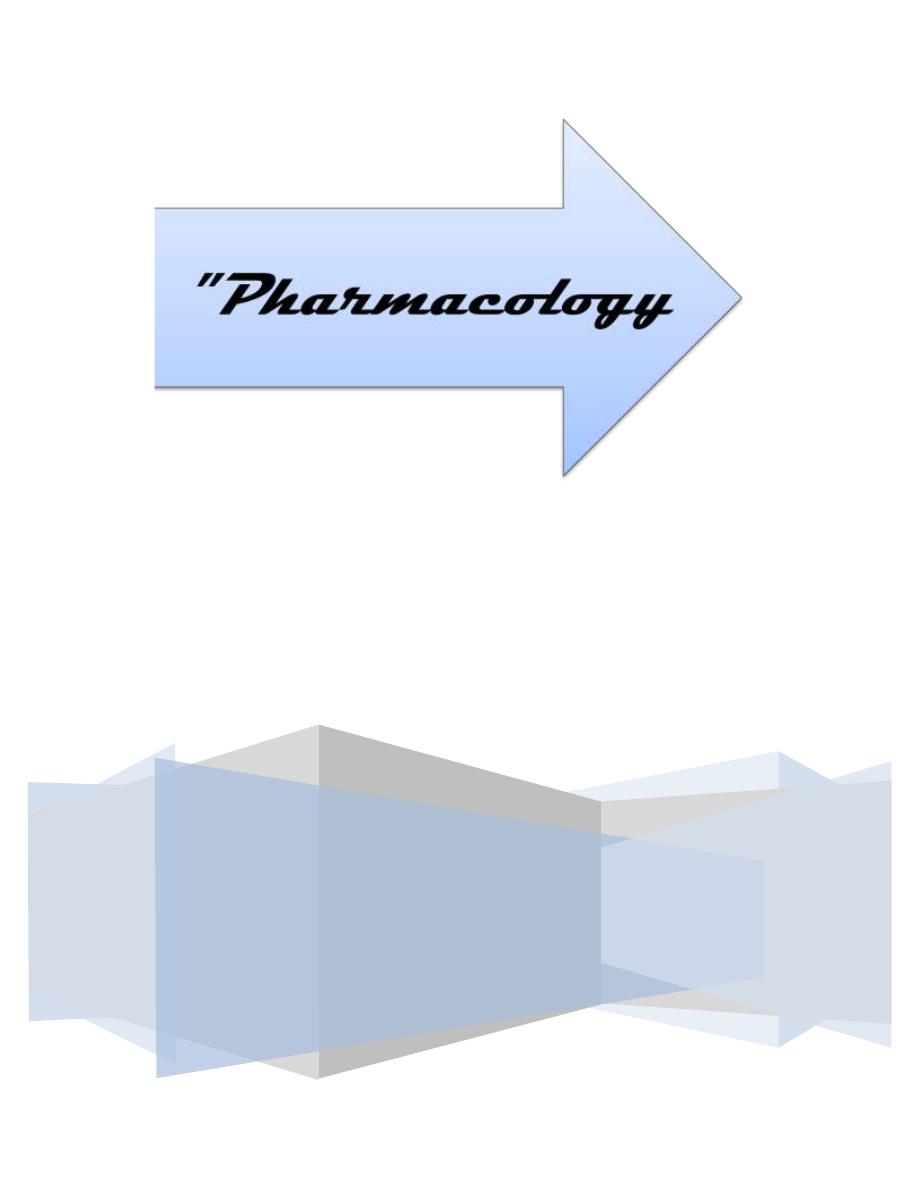
Sunday 14 / 12 / 2014
©Ali Kareem 2014-2015
Name
:
______________________________
Class
:
_______________________________
مكتب اشور لالستنساخ
General Anesthetics
Lecture 1
Total lectures NO. 28
Dr. Huda Al-Qadhi

Anesthetics:
A drug, administered for medical or surgical purposes, that induces
partial or total loss of sensation and may be topical, local, regional, or
general, depending on the method of administration and area of the body
affected.
1-Preanesthetic medication:
a-Anticholinergic
b-Antiemetic.
c- Sedative / Hypnotic / Anxiolytics
d- Opioid Analgesics
e-Muscle relaxant.
2-General anesthetic
3- local anesthetics.
1-Preanesthetic medication:
Anaesthetic premedication consists of a drug or combination of drugs
that serve to complement or otherwise improve the quality of the
anaesthetic.
a-Anticholinergic:
– Atropine
– Hyoscine
– Glycopyrronium

Used to
1. Decreased secretions, preventing laryngospasm
2. Avoiding problems during intubation
3. Also suppress secretions in GIT, decreasing the chances of
aspiration.
b-Antiemetics
– Metoclopramide
– Antihistamines
– Phenothiazines –Promethazine used
– 5HT
3
Receptor Blockers
•Ondansetron
•Tropisetron
•Granisetron
Use
Antiemetics enhance gastric emptying. They are used to prevent nausea,
vomiting in patients. Most commonly used is Metoclopramide.
Antihistamines are also used for this purpose. They are not only
antiemetic but also used for:
1. Sedative property
2. Relieving anxiety
3. Anti-cholinergic effect
Patients having cancer chemotherapy have some vomiting. 5HT receptor
blockers are used to protect. Nowadays Ondansetron is also in use in
patients as pre-anesthetic

C-Opioid Analgesics
– Morphine
– Pethidine
– Fentanyl & its congeners
– Use
Given to provide sufficient analgesia during procedure and post
operatively.
d-Sedative / Hypnotic / Anxiolytics
– Benzodiazepines (still commonly used)
· Diazepam
· Lorazepam
· Midazolam
– Barbiturates (not used much)
· Secobarbital
· Pentobarbital
– Use
They decrease the anxiety, make the person relax and drowsy, providing
amnesia.
e-Muscle relaxants
Muscle relaxants do not render patients unconscious or relieve pain.
Instead, they are sometimes used after a patient is rendered unconscious
(induction of anesthesia) to facilitate
skeletal muscle.

General anesthetics:
A general anaesthetic is a drug that has the ability to bring about a
reversible loss of consciousness.
Purpose
General anaesthesia has many purposes including:
1. Analgesia — loss of response to pain,
2. Amnesia — loss of memory,
3. Immobility — loss of motor reflexes,
4. Unconsciousness — loss of consciousness
5. Skeletal muscle relaxation
Patient Factors in Selection of Anesthesia
1. Status of organ systems
1. Cardiovascular system
Anesthetic agents suppress cardiovascular function to varying
degrees. Ischemic injury to tissues throughout the body may follow
reduced perfusion pressure if a hypotensive episode develops
during anesthesia. Treatment with vasoactive substances may be
necessary. Some anesthetics, such as halothane, may sensitize the
heart to the arrhythmogenic effects of sympathomimetic agents.
2. Respiratory system
Inhaled anesthetics depress the respiratory system and act as
bronchodilators. IV anesthetic agents and opioids suppress
respiration. These effects on pulmonary function may influence the
ability to provide adequate ventilation and oxygenation during
surgery and postoperatively.

3. Liver and kidney
Because the liver and kidney influence the long-term distribution
and clearance of anesthetic agents ,the physiologic status of these
organs must be considered. The release of fluoride, bromide, and
other metabolic products of the halogenated hydrocarbons can
affect these organs, especially if the metabolites accumulate with
repeated anesthetic administration over a short period of time.
4. Nervous system
The existence of neurologic disorders (for example, epilepsy,
myasthenia gravis, neuromuscular disease, and compromised
cerebral circulation) influences the selection of an anesthetic, as
would a patient history suggestive of a genetically determined
sensitivity to malignant hyperthermia .
5. Pregnancy
In early pregnancy, potential effects on organogenesis in the fetus
are a major concern. Transient use of nitrous oxide has been
reported to cause aplastic anemia in the unborn child. Oral clefts
have occurred in the fetuses of women who have received
benzodiazepines during early pregnancy. Benzodiazepines should
not be used routinely during labor, because of resultant temporary
hypotonia and altered thermoregulation in the newborn.
2. Concomitant use of drugs
1.
Multiple adjunct agents
Commonly, surgical patients receive one or more reanesthetic
medications:
These agents facilitate smooth induction of anesthesia and, when
administered concurrently, also lower the dose of anesthetic
required to maintain the desired level of surgical anesthesia.
However, such coadministration can also enhance undesirable

anesthetic effects (for example, hypoventilation), and may produce
negative effects that are not observed when each drug is given
individually.
2.
Concomitant use of additional nonanesthetic drugs
Surgical patients may be chronically exposed to agents for the
treatment of underlying diseases, as well as to drugs of abuse that
alter their response to anesthetics. For example, alcoholics have
elevated levels of hepatic microsomal enzymes involved in the
metabolism of anesthetics, and drug abusers may be overly tolerant
of opioids.
Induction ,maintenance and recovery
Induction
Most general anaesthetics today are induced either with a needle, by
intravenous injection, or by breathing a volatile anaesthetic through an
anaesthetic circuit (inhalational induction). Onset of anaesthesia is faster
with intravenous injection than with inhalation, taking about 10–20
seconds to induce total unconsciousness.
Maintenance.
The duration of action of intravenous induction agents is in general 5 to
10 minutes, after which time spontaneous recovery of consciousness will
occur. In order to prolong anaesthesia for the required duration (usually
the duration of surgery), anaesthesia must be maintained. Usually this is
achieved by allowing the patient to breathe a carefully controlled
mixture of oxygen, nitrous oxide, and a volatile anaesthetic agent or by
having a carefully controlled infusion of medication
Recovery
Emergence is the process of return to baseline physiologic function of all
organ systems after the cessation of administration of general anaesthetic

agent(s). This stage of general anaesthesia may be accompanied by
certain unusual but temporary neurologic phenomena, such as agitated
emergence, aphasia ,or focal impairment in sensory or motor function.
Depth of anesthesia.
Stage 1
Stage 1 anaesthesia” analgesia” During this stage, the patient
progresses from analgesia without amnesia to analgesia with
amnesia. Patients can carry on a conversation at this time.
Stage 2
Stage 2 anaesthesia, also known as the "excitement stage", is the
period following loss of consciousness and marked by excited and
delirious activity. During this stage, respirations and heart rate may
become irregular.
Stage 3
Stage 3, "surgical anaesthesia". During this stage, the skeletal
muscles relax, vomiting stops, and respiratory depression occurs .
Eye movements slow, then stop, the patient is unconscious and
ready for surgery. It has been divided into 4 planes:
Stage 4
Stage 4 anaesthesia, also known as "Medullary paralysis", is the
stage where too much medication has been given relative to the
amount of surgical stimulation and the patient has severe brain
stem or medullary depression. This results in a cessation of
respiration and potential cardiovascular collapse. This stage is
lethal without cardiovascular and respiratory support.
Inhalation Anesthetics
used primarily for the maintenance of anesthesia after administration of
an IV agent.
One advantage of inhalation anesthetics is that the depth of anesthesia
can be rapidly altered by changing the inhaled concentration of the drug.

Potency
The potency of inhaled anesthetics is defined quantitatively as the
minimum alveolar concentration (MAC). This is the end-tidal
concentration of anesthetic gas needed to eliminate movement among 50
percent of patients challenged by a standardized skin incision. MAC is
small for potent anesthetics, such as sevoflurane, and large for less
potent agents, such as nitrous oxide (N
2
O). Therefore, the inverse of
MAC is an index of the potency of the anesthetic.
Uptake and distribution of inhalation anesthetics
The principal objective of inhalation anesthesia is to achieve a constant
and optimal brain partial pressure (P
br
) of the inhaled anesthetic. Thus,
the alveoli are the “windows to the brain” for inhaled anesthetics. The
partial pressure of an anesthetic gas at the origin of the respiratory
pathway is the driving force that moves the anesthetic into the alveolar
space and, thence, into the blood, which delivers the drug to the brain
and various other body compartments. Because gases move from one
compartment to another within the body according to partial pressure
gradients, a steady state is achieved when the partial pressure in each of
these compartments is equivalent to that in the inspired mixture. [Note:
At equilibrium, alveolar partial pressure = arterial partial pressure =
brain partial pressure, or P
A
= P
a
= P
br
.]
Mechanism of action
No specific receptor has been identified as the locus of general
anesthetic action. The focus is now on interactions of the inhaled
anesthetics with proteins comprising ion channels.
For example, the general anesthetics increase the sensitivity of the
γ-aminobutyric acid (GABA
A
) receptors to the neurotransmitter,
GABA, at clinically effective concentrations of the drug. This
causes a prolongation of the inhibitory chloride ion current after a
pulse of GABA release. Postsynaptic neuronal excitability is, thus,
diminished.

Other receptors are also affected by volatile anesthetics. For
example, the activity of the inhibitory glycine receptors in the
spinal motor neurons is increased.
In addition, the inhalation anesthetics block the excitatory
postsynaptic current of the nicotinic receptors. The mechanism by
which the anesthetics perform these modulatory roles is not
understood.
Inhaled agents
Desflurane
Volatile agents are specially formulated organic liquids that
evaporate readily into vapors, and are given by inhalation for
induction and/or maintenance of general anesthesia.
Nitrous oxide is a gase at room temperature rather than liquid, so it
is not considered volatile agent.
The ideal anesthetic vapor or gas should be
non-flammable, non-explosive, and lipid-soluble.
It should possess low blood gas solubility
have no end-organ (heart, liver, kidney) toxicity or side-effects.
should not be metabolized, and should not be an irritant to the
respiratory pathways of the patient.
No anaesthetic agent currently in use meets all these requirements,
nor can any anaesthetic agent be considered safe.

The agents in widespread current use are isoflurane, desflurane,
sevoflurane, and nitrous oxide. Nitrous oxide is a common
adjuvant gas, making it one of the most long-lived drugs still in
current use. Because of its low potency, it cannot produce
anesthesia on its own but is frequently combined with other agents.
Halothane, an agent introduced in the 1950s, has been almost
completely replaced in modern anesthesia practice by newer agents
because of its shortcomings. Partly because of its side effects,
enflurane never gained widespread popularity.
In theory, any inhaled anesthetic agent can be used for induction
of general anesthesia. However, most of the halogenated
anesthetics are irritating to the airway, perhaps leading to
coughing, laryngospasm and overall difficult inductions. For this
reason, the most frequently used agent for inhalational induction is
sevofluran.
All of the volatile agents can be used alone or in combination with
other medications to maintain anesthesia (nitrous oxide is not
potent enough to be used as a sole agent).
Intravenous agents (non-opioid)
While there are many drugs that can be used intravenously to produce anesthesia or
sedation, the most common are:

The
two
barbiturates
mentioned
above,
thiopental
and
methohexital, are ultra-short-acting, and are used to induce and
maintain
anesthesia.
However,
though
they
produce
unconsciousness, they provide no analgesia (pain relief) and must
be used with other agents.
Benzodiazepines can be used for sedation before or after surgery
and can be used to induce and maintain general anesthesia. When
benzodiazepines are used to induce general anesthesia, midazolam
is preferred. Benzodiazepines are also used for sedation during
procedures that do not require general anesthesia. Like
barbiturates, benzodiazepines have no pain-relieving properties.
Propofol is one of the most commonly used intravenous drugs
employed to induce and maintain general anesthesia. It can also be
used for sedation during procedures or in the ICU. Like the other
agents mentioned above, it renders patients unconscious without
producing pain relief.

Ketamine is infrequently used in anesthesia because of the
unpleasant experiences that sometimes occur on emergence from
anesthesia, which include "vivid dreaming, and illusions."
However, like etomidate it is frequently used in emergency settings
and with sick patients because it produces fewer adverse
physiological effects.
Unlike the intravenous anesthetic drugs previously mentioned,
ketamine produces profound pain relief, even in doses lower than
those that induce general anesthesia. Also unlike the other
anesthetic agents in this section, patients who receive ketamine
alone appear to be in a cataleptic state, unlike other states of
anesthesia that resemble normal sleep.
Intravenous opioid analgesic agents
While opioids can produce unconsciousness, they do so unreliably and
with significant side effects. So, while they are rarely used to induce
anesthesia, they are frequently used along with other agents such as
intravenous non-opioid anesthetics or inhalational anesthetics.
Furthermore, they are used to relieve pain of patients before, during, or
after surgery. The following opioids have short onset and duration of
action and are frequently used during general anesthesia:
The following agents have longer onset and duration of action and are
frequently used for post-operative pain relief:

Meperidine or pethidine
Intravenous reversal agents
Flumazenil, reverses the effects of benzodiazepines
Naloxone, reverses the effects of opioids
Neostigmine, helps reverse the effects of non-depolarizing muscle
relaxants
Sugammadex, new agent that is designed to bind Rocuronium
therefore terminating its action
